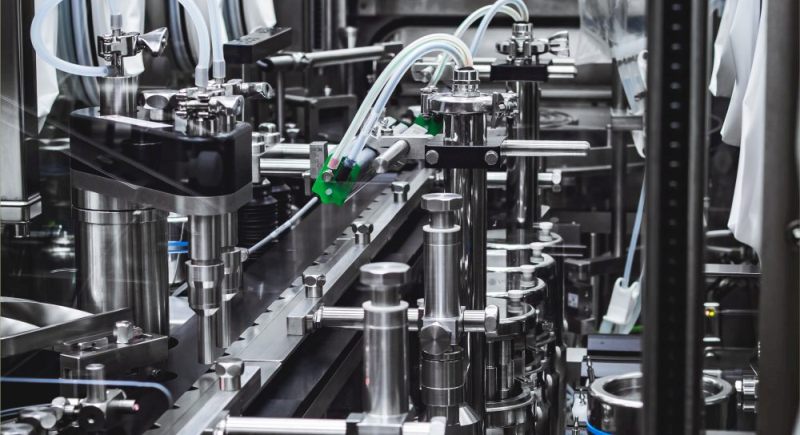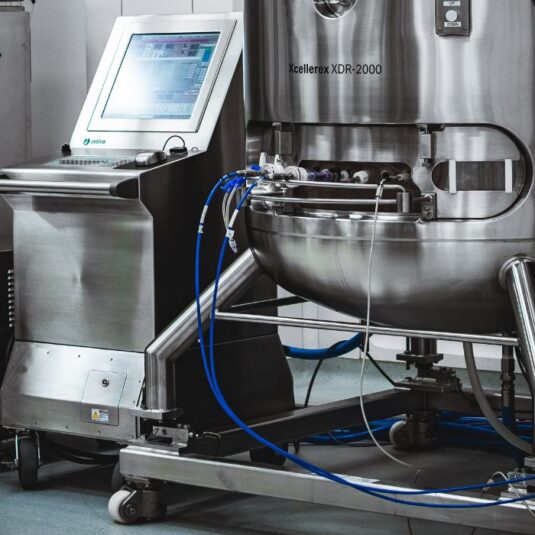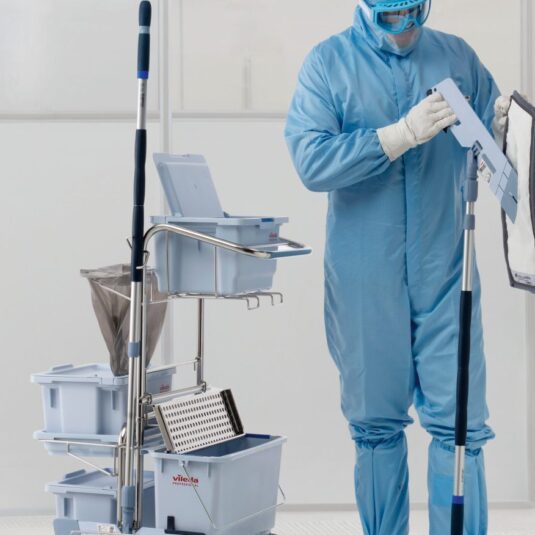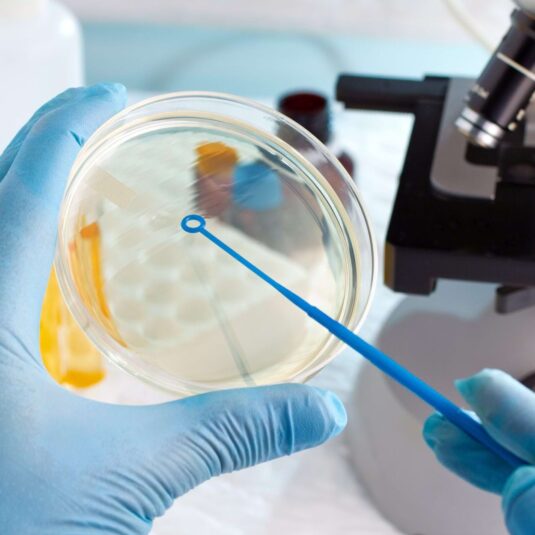Aseptic Filling in Modern Pharmaceutical Manufacturing
Drug product, Manufacturing
Aseptic filling is a critical step in pharmaceutical manufacturing, especially for biologic drugs. It is the process of filling sterile drug product into sterile containers (vials, syringes, etc.) in a way that maintains sterility throughout. Because most biologics cannot withstand terminal sterilization (exposure to heat or radiation in the final container), they must be filled under aseptic conditions. Any contamination at this stage can put patients at serious risk and derail a product’s development. Regulatory agencies therefore require that sterile products, particularly injectables, undergo aseptic filling in strict compliance with Good Manufacturing Practice (GMP) standards before they can be released. In recent years, advancements in aseptic processing technology and improved process controls have greatly enhanced the safety and efficiency of fill-finish operations, enabling manufacturers to better assure product sterility and quality.
The Importance of Aseptic Filling in Pharmaceutical Manufacturing
Aseptic filling is often the final, crucial step in drug manufacturing that directly impacts patient safety. It is especially vital for biologic therapies which are usually administered by injection and must be sterile because they bypass the body’s normal defenses. Unlike small-molecule drugs that might be sterilized in the final container, biologics are typically too sensitive to undergo terminal sterilization, so achieving sterility hinges entirely on an aseptic filling process. This makes fill-finish a gatekeeper of quality: if even a single microorganism enters a batch during filling, the whole lot may be lost and patients could be harmed. Indeed, no lot of injectable drug can be released without passing sterility tests, underscoring how sterility assurance is mandatory for product approval.1
Beyond microbial contamination, product integrity is also at stake during filling. The act of pumping and dispensing a delicate biologic solution can affect its quality. For example, excessive shear stress or interaction with surfaces might degrade a protein. Thus, the choice of filling equipment and the handling of the product at this step can influence the final drug’s efficacy and safety.
Given its paramount importance, many biopharmaceutical companies consider aseptic filling a core competency that must be tightly controlled. In practice, this often means using specialized technology and highly trained personnel to create an environment where the product is filled sterilely and smoothly, without compromising quality. The critical nature of aseptic filling has also led to a trend of outsourcing this step to expert contract development and manufacturing organizations that have invested in state-of-the-art fill-finish facilities.2 By partnering with such specialists, drug developers can leverage top-notch sterility assurance without building the infrastructure in-house, ensuring that life-saving therapies reach patients safely.
Key Challenges in Aseptic Filling – Maintaining Sterility and Product Integrity

Aseptic filling is recognized as one of the most challenging operations in pharmaceutical production. Maintaining sterility throughout the process is the foremost challenge, since biologic products cannot rely on a end-of-process sterilization. Every step must occur in an ultra-clean environment to avoid introducing any microbes or particulates. Humans are a major source of contamination, so any manual intervention in a filling line carries risk. In fact, the updated EU GMP Annex 1 guidelines explicitly emphasize minimizing human interventions in aseptic processes. Aseptically filled products inherently carry higher risk than terminally sterilized products, because any viable contaminant that enters the container will remain in the final product. The consequences of a contamination incident can be catastrophic – leading to batch loss, clinical trial delays, or patient harm – so multiple layers of contamination control are required.3
In addition to sterility, product integrity must be preserved during filling. Biologic formulations are often complex and sensitive: for example, high-concentration monoclonal antibody solutions can be extremely viscous, which complicates filling. Pumping a very viscous liquid through fine needles can cause pressure fluctuations or even nozzle clogging.4 Manufacturers have observed issues like drying of protein solution at the needle tip causing blockages, or inconsistent fill volumes when dealing with thick fluids. Moreover, forcing viscous or foaming liquids through small-diameter pathways can create shear stresses on the protein molecules. Such mechanical stress may denature proteins or cause them to aggregate, undermining the product’s efficacy. Studies have shown that pumping conditions must be carefully optimized.5
Another challenge is ensuring the container-closure integrity after filling. Vials or syringes must be sealed tightly (with sterile stoppers and caps) to prevent any ingress of contaminants during storage. Even microscopic leaks can let in bacteria or fungi over time. Techniques like helium leak testing or high-voltage leak detection are often employed to verify seal integrity. For lyophilized (freeze-dried) products, aseptic filling includes additional complexity: partially stoppered vials are transferred to a lyophilizer, then fully sealed later, adding steps that must be tightly controlled to maintain sterility. Overall, aseptic filling requires a combination of robust process design, appropriate technology, and highly disciplined operator technique to surmount these challenges. Many companies address these difficulties by using advanced equipment (e.g. isolators and automated filling lines) and by relying on experienced CDMOs with deep expertise in aseptic processing. This ensures that despite the challenges, sterility and product quality can be consistently achieved at fill-finish.
Innovations in Aseptic Filling Technology – Enhancing Efficiency and Safety
To meet these challenges, the industry has embraced a wave of technological innovations in aseptic filling. One major area of progress is the adoption of barrier systems which separate the filling operation from the external environment. Modern filling lines often operate inside sealed isolators that are bio-decontaminated with vaporized hydrogen peroxide (VHP) before use. Isolators allow the filling to take place in an ISO 5 (Grade A) atmosphere with virtually no direct human contact, drastically reducing the risk of microbial contamination. Likewise, Restricted Access Barrier Systems (RABS) provide a physical barrier (with glove ports for any interventions) to protect the product. These systems have become increasingly standard, especially after regulators signaled a preference for barrier technology in recent guidelines. The result is a much safer process. Isolator-based ascepting filling has been shown to virtually eliminate human-borne contamination from the line.
Automation and robotics go hand-in-hand with barrier systems. Today’s advanced aseptic filling lines use robotic arms and automated mechanisms for container handling, filling, and closing. Removing human hands from the process not only improves sterility, but also increases precision and throughput. Automated fill-finish machines equipped with vision systems and sensors can perform 100% in-process weight checks on filled vials, ensuring each unit is within the target volume. If a deviation is detected, the system can reject a vial immediately, thereby preventing downstream issues.2
Another significant innovation is in filling pump technology. Traditional filling pumps (such as rotary piston pumps) are robust but can be rough on sensitive biologics and may have many product-contact parts. Newer systems are designed for gentler handling and greater accuracy. Peristaltic pumps have long been popular for their smooth operation and easy cleaning. Recent designs like radial and linear peristaltic pumps improve on this concept, providing pulse-free flow and minimizing shear. There are also time-pressure filling systems, where a controlled pressurized reservoir dispenses the liquid for a set time, yielding accurate volumes without mechanical pistons. However, each technology comes with considerations. For instance, peristaltic pumps may shed particles from the tubing over time, and time-pressure systems require careful pressure calibration.6
The rise of single-use technology has also transformed aseptic filling. Single-use fluid path components eliminate the need for complex cleaning and sterilization between batches. Instead of stainless steel equipment that must be rigorously cleaned (with risk of residues) and autoclaved, a disposable filling kit can be used once and discarded. This greatly reduces changeover time and cross-contamination risk, and it provides flexibility for multi-product facilities. The pre-sterilized single-use fill assembly can be quickly installed in an isolator for one product, then swapped out for a different assembly for the next product, with minimal downtime. Such approaches have become common, especially in facilities handling many small batches or clinical trial fills. Single-use systems bypass the issue of product adsorption to equipment surfaces, since the tubing and wetted surfaces can be chosen specifically for compatibility with the biologic.
Finally, innovations in supporting technologies have improved aseptic filling safety. For instance, modern fill lines typically include an in-line depyrogenation tunnel to sterilize and depyrogenate glass vials via high dry heat before they enter the filling area. These tunnels can heat vials to ~250–300 °C for sufficient time to destroy bacterial endotoxins, ensuring the containers are not just sterile but also pyrogen-free.
Aseptic Filling Process – Best Practices for Ensuring Compliance with GMP Standards
Because aseptic filling is high-risk, global regulatory agencies have set forth stringent guidelines and best practices to govern this process. Compliance with these GMP standards is non-negotiable for any manufacturer of sterile pharmaceuticals. One cornerstone principle is that all aseptic filling operations must occur in a properly designed cleanroom environment of appropriate cleanliness grade. In practice, this means the filling of sterile drug product should take place in a Grade A (ISO Class 5) air quality zone, typically within a laminar airflow hood or isolator, and usually with a Grade B background cleanroom as support. The Grade A “critical area” is where the product, container, and closures are exposed to the environment; here, unidirectional (laminar) HEPA-filtered air at positive pressure is used to sweep away any particles or microbes, maintaining an extremely low contamination level. Surrounding this, the Grade B area (often the room housing an isolator or RABS) provides a second layer of cleanliness and serves as a buffer. Further away, Grade C and D areas are used for less critical steps or preparation activities. This cleanroom cascade (Grade A surrounded by B, etc.) with pressure differentials is a fundamental design specified by regulators to reduce the chance of contaminants entering the critical filling zone.7
Another key GMP requirement is robust personnel practices and training for aseptic operations. Humans are both a necessary part of aseptic processes and the greatest contamination risk. Regulations therefore mandate that anyone who works in Grade A/B environments be highly trained in aseptic techniques, gowning, and cleanroom behavior. Operators don sterile protective garments (coveralls, masks, gloves, goggles) in a Grade B changing room before entering the filling area, and they follow strict procedures to minimize motion and avoid touching critical surfaces.7 Regular qualification tests are performed. Personnel might have to pass media-fill simulations of interventions, and their aseptic gowning is periodically evaluated for contamination. If an operator shows a lapse (like microbial growth detected on a glove fingerprint sample), retraining or disqualification may occur. These measures align with the principle that people can be the weakest link in aseptic processing, so only well-trained, qualified staff should have access, and even then their involvement is kept to the minimum necessary.
From a process validation standpoint, one of the most important GMP best practices is conducting aseptic process simulations, commonly known as media fills. A media fill is a test of the aseptic filling process where a growth medium is filled into containers instead of the actual drug, under as close to real process conditions as possible. The idea is to simulate the routine process, including any worst-case interventions or pauses, to see if any contamination occurs. After filling, the containers of media are sealed and incubated for a specified time to allow any contaminating microorganisms to grow. The expectation for a successful media fill is zero contaminated units out of thousands filled. Even a single growing container (turbid with microbial growth) typically constitutes a failure, triggering a thorough investigation. Media fills must be performed at the initial qualification of the aseptic process and periodically thereafter (e.g. semi-annually) to re-validate that the process remains in control. Regulators scrutinize media fill records in inspections, because they are direct evidence of the process’s capability to produce sterile product consistently.8
In addition to media fills, GMP rules enforce many other controls and tests. Environmental monitoring is continuous in critical areas. Airborne particle counts and microbial settle plates or air samples are taken during each fill. Alert and action levels are defined (for instance, ISO 5 areas must have <1 colony-forming unit per cubic meter of air, ideally zero), and any excursion demands investigation. Also, each batch of finished product is subject to a formal sterility test. Samples of the filled product are incubated in growth media to see if any microbes are present. Only if the sterility test is passed can the batch be released.
Global regulatory guidelines align on these best practices. The recently revised Annex 1 in particular has introduced even more explicit expectations: for example, it calls for a formal Contamination Control Strategy and encourages adoption of advanced technologies to reduce contamination risk. It also specifies detailed requirements for cleanroom classification and monitoring, sterile filtration of products, container closure integrity testing, and more.3 In essence, compliance with GMP in aseptic filling means building quality into the process at every step. By following best practices manufacturers ensure that each unit coming off an aseptic filling line is as safe and sterile as intended. This high level of control and documentation is laborious, but it is absolutely crucial for patient safety and for meeting the regulatory standards that allow sterile drugs (especially novel biologics) to reach the market.
The Role of Cleanroom Design and Environmental Control in Aseptic Filling
Cleanroom design and environmental control form the backbone of any successful aseptic filling operation. Since the goal is to keep the product sterile and free of particulates, the environment in which filling occurs must be rigorously engineered to exclude contaminants. The highest level is the Grade A zone where open product is handled – typically under a unidirectional laminar airflow unit. The cleanroom’s air handling systems push HEPA-filtered air downward in smooth parallel streams over the filling area. This laminar flow serves to constantly sweep away any particles or microbes that might be shed from equipment or personnel, and it prevents turbulent eddies where contaminants could stagnate. Airflow visualization studies are often done (using smoke or vapor) to verify that the Grade A area has no dead zones and that air moves uniformly outwards, carrying contaminants away from the critical surfaces. Additionally, the cleanroom air is maintained at a positive pressure relative to adjacent lower-grade rooms, so that if any leakage occurs, air flows outward (keeping contaminants from entering the critical area).
A well-designed cleanroom follows a graded zoning concept: for example, a filling line inside an isolator has the isolator interior as Grade A, the surrounding room as Grade B, and perhaps anti-chambers or corridors as Grade C/D. Each step outward allows a higher particle count, but the gradient ensures that the most sensitive point (the filling needle and open containers) has the cleanest air. HEPA filters are employed not only at the point of fill but also in HVAC systems supplying the background rooms, maintaining specified air cleanliness in each zone.9 The materials of construction in cleanrooms are chosen to be non-shedding, smooth, and easily cleanable – for instance, floors and walls are often epoxy-coated or made of vinyl, with coved corners to avoid dirt traps. Stainless steel is used for equipment for its cleanability and low particle generation. Cleanroom suites are equipped with airlocks for material and personnel entry, where airflow and high-frequency door interlocks help prevent the influx of contaminated air from outside.
Crucially, environmental control in aseptic filling is not just about initial design but also ongoing monitoring and maintenance. Sensors count airborne particulates in real time during filling operations, and samples are taken to monitor microbial levels. If a trend of rising particle counts is observed, it may indicate an HVAC issue or an inappropriate intervention, prompting corrective action. GMP guidelines now emphasize continuous monitoring in Grade A/B areas as a best practice for early detection of contamination risks. Cleanrooms must also be regularly cleaned and disinfected to control any surface microbes. Typically, a rotational disinfection regime is used, often including a sporicidal agent (to address bacterial spores) on a defined schedule. Even the layout of equipment in the filling room is carefully planned to minimize turbulence and to streamline cleaning; for example, equipment is spaced to allow manual or automated cleaning tools to access all areas.
One of the most impactful aspects of cleanroom design in recent years is the incorporation of closed aseptic processing zones, like isolators. As mentioned, isolators physically separate the filling environment from the larger cleanroom. This means that the surrounding room can be a lower grade (often Grade C) if the isolator is well-sealed and meets Grade A conditions inside. Open isolators (with carefully engineered openings to the environment) or closed isolators (no direct openings, using transfer ports) are used. These systems still reside in at least a Grade C background, but they greatly reduce the cleanroom footprint needed for Grade B space. They also ease the burden on environmental control. It’s easier to hold a small isolator at ISO 5 with VHP sterilization than to maintain a large room at that level. This has enabled higher assurance of sterility and often lower operating cost.
In summary, cleanroom design and environmental controls are meticulously planned to create an envelope of cleanliness around the aseptic filling process. Proper airflow (laminar, HEPA-filtered, unidirectional) ensures particulates are diluted and removed. Pressure differentials and airlocks prevent dirty air ingress. Smooth, cleanable surfaces and automation of cleaning make it possible to repeatedly sanitize the environment. Ongoing monitoring verifies that conditions remain within specs at all times. If any parameter strays (for example, a momentary uptick in particle count due to an intervention), procedures are in place to respond – such as halting the fill, correcting the cause, and evaluating any product impact. The ultimate goal is an environment where the risk of contamination is as low as technologically possible. By investing in high-grade cleanroom infrastructure and rigorously controlling the environment, manufacturers lay the foundation that allows aseptic filling to succeed.
Future Trends in Aseptic Filling – Automation, Continuous Processing and Beyond
Looking ahead, the field of aseptic filling is evolving toward even greater automation, efficiency, and adaptability. One clear trend is the move toward fully automated, robotics-driven filling systems. While many facilities today use some automation, the future is exemplified by technologies like gloveless robotic isolators. In these systems, a robotic filling machine operates entirely inside a sealed isolator without the need for glove ports (human hands never directly enter the isolator). This configuration virtually eliminates the chance of human-introduced contamination and can drastically cut down interventions and downtime. This not only improves sterility assurance but also lends itself to data-rich process control. Automated sensors can log every action, enabling real-time monitoring and use of artificial intelligence to detect anomalies or drifts in the process.10
Another major development on the horizon is the implementation of continuous aseptic processing. Traditionally, fill-finish is a batch operation – a set number of vials are filled, then the machine is stopped and cleaned for the next batch. But the industry is exploring continuous manufacturing paradigms for sterile products, where the process could run indefinitely with ingredients fed in and filled product coming out in a steady stream. Continuous aseptic filling could involve an in-line formulation system connected to an isolator filling line, with automatic vial washing, sterilization, filling, and sealing all in sequence. In fact, some modern facilities already achieve a semi-continuous flow: for example, in under 30 minutes a vial can go from washer, through a depyrogenation tunnel, into filling and sealing without any operator intervention or recontamination in that span. Notably, once sterile conditions are established in a closed continuous system, they can be maintained for extended periods (days or even weeks) without interruption. While fully continuous sterile manufacturing of drugs is still in its infancy, pilot implementations are promising.11
We also foresee increased use of closed, single-use systems and modular facilities to handle the next generation of biopharmaceuticals. Cell therapies and gene therapies, for instance, often involve small batch sizes and very high product value per volume. For these, flexible filling solutions systems that can aseptically fill a few hundred vials or syringes in a fully closed manner. Technologies like microbatch fillers in isolators or specialized cartridge-filling robots are emerging to meet this need. Because advanced therapies are so sensitive (and sometimes cannot tolerate even slight temperature excursions or delays), the fill-finish equipment for these might be placed in close proximity to manufacturing suites (to minimize transfer time) or designed to integrate filling with formulation steps.
Conclusion
Aseptic filling remains a cornerstone of modern pharmaceutical manufacturing, enabling sterile drugs to reliably reach patients. It is a demanding endeavor, requiring significant investment in facilities, technology, and training to maintain uncompromising sterility and quality. Advances in equipment are steadily improving the safety and efficiency of fill-finish operations. At the same time, stringent GMP compliance ensure that no contamination breaches this last barrier of defense. For biopharma companies developing novel therapies, partnering with a specialized aseptic filling CDMO can be a strategic choice, granting access to state-of-the-art fill-finish capabilities and cost-effective expertise. By leveraging such partnerships innovators can focus on science and patients while entrusting the critical fill-finish step to experts.
Prepared by:

Jakub Knurek
Marketing Specialist
References
- Cuffari B. Advances in Aseptic Processing: The Future of Sterile Pharmaceutical Manufacturing. News-Medical Life Sciences. 2024.
- Wright T. Fill-Finish Outsourcing Trends. Contract Pharma. 2025.
- European Medicines Agency. EU GMP Annex 1: Manufacture of Sterile Medicinal Products. 2022.
- Pardeshi N, Marsiglio D, Padmakumar V, Bernacki J, Rathore N. Investigating and Addressing Challenges Associated with Filling Protein Drug Products. J Pharm Sci. 2023; 112(4): 954-962.
- Kovarcik DP. Critical Factors for Fill–Finish Manufacturing of Biologics. BioProcess International. 2016.
- Adler M, Allmendinger A. Filling Unit Operation for Biological Drug Products: Challenges and Considerations. J Pharm Sci. 2024; 113(2): 332-344.
- ISO 14644 Standards. Cleanrooms and associated controlled environments. 2015.
- Hernandez R. Best Practices for Sterility Assurance in Fill/Finish Operations. BioPharm International. 2015; 28(11): 14-19.
- Xu Z. Principle of Cleanroom. Fundamentals of Air Cleaning Technology and Its Application in Cleanrooms. 2013: 377-465.
- Hartman Z., Boman P. Robotic gloveless isolator technology enhances regional production of advanced therapeutics. Cell & Gene Therapy Insights, 2025; 11(2): 175-181.
- Rantanen J, Khinast J. The Future of Pharmaceutical Manufacturing Sciences. J Pharm Sci. 2015; 104(11): 3612-3638.


